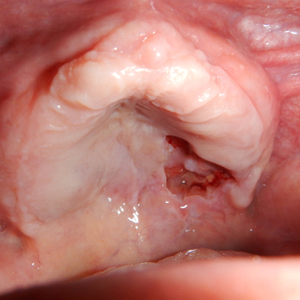
What are non-Hodgkin's lymphomas?
The term non-Hodgkin's lymphoma stands for various malignant cancers of the lymphatic system and is often also called "malignant lymphoma", which means "malignant lymph node tumour". Non-Hodgkin's lymphomas originate from cells of the lymphatic system and develop when the genetic material of the cells of the lymphatic system (lymphocytes) changes. B lymphocytes are responsible for this change in 90 percent of all cases and T lymphocytes in 10 percent of all cases. Since lymph tissue is found throughout the human body, the disease non-Hodgkin's lymphoma is not locally limited. Although the lymph nodes are affected more often than average, the cancer can also affect the lungs, liver, bone marrow or spleen, especially in advanced stages. In contrast to other types of cancer, non-Hodgkin's lymphomas occur relatively rarely. Every year, about 9,200 men with an average age of 70 and about 8,000 women with an average age of 72 develop the disease in Germany.
What is the lymphatic system?
The lymphatic system is not a single organ, but all the lymphatic channels that are distributed throughout the human body. In addition to the lymph nodes, the lymphatic organs also include the spleen, the lymphatic tissue in the gastrointestinal tract and in the throat, and the thymus gland. In addition, the immune system is closely connected to the lymphatic system via a group of white blood cells (lymphocytes), which have the central task of immune defence. Doctors distinguish between B and T lymphocytes, which are all produced by the bone marrow. Although the two types take on different tasks in the immune defence, they work together within the body's own immune defence.
How do non-Hodgkin's lymphomas develop?
Doctors still cannot completely explain the causes of non-Hodgkin's lymphoma. However, there are certain risk factors that increase the probability of developing non-Hodgkin's lymphoma. These include, for example, changes in the chromosomes, which allow conclusions to be drawn about the fact that a change in the genetic material has taken place. But exposure to certain chemical substances, exposure to radioactive radiation, problems in the immune system, smoking, age and late effects of certain viral infections can also contribute to the development of non-Hodgkin's lymphomas.
Who has an increased risk of developing non-Hodgkin's lymphoma?
HIV patients in particular have an increased risk of developing non-Hodgkin's lymphoma due to their weakened immune system. But the risk of contracting the disease is also increased in organ recipients due to the use of highly potent immunosuppressive drugs. For other groups of people, no specific risk groups can be defined so far, which is why no specific preventive measures can be taken.
What are the symptoms of non-Hodgkin's lymphoma?
Similar to other types of cancer, non-Hodgkin's lymphoma does not initially cause any specific symptoms that can be attributed exclusively to the disease. Often, at the beginning of the disease, there is only a painless swelling of the lymph nodes, although this can also be a sign of an infectious disease. However, many sufferers complain of the following cold-like symptoms, which are indicative of non-Hodgkin's lymphoma, but may also have other explanations:
- Loss of appetite
- unwanted weight loss
- Listlessness, paleness, fatigue
- Itching
- Night sweats, fever
How are non-Hodgkin's lymphomas treated?
Treatment always depends on the stage of the cancer, but also on the spread of the tumour and the patient's general state of health. As a rule, the following treatment options are available for non-Hodgkin's lymphoma. Surgery is generally ruled out because non-Hodgkin's lymphoma is a systemic disease. This means that it affects the whole body and therefore at most allows the removal of individual lymph nodes.
- Chemotherapy: can be used effectively for highly malignant lymphomas, even at a late stage of the cancer
- Radiotherapy: can be used for slow-growing low-malignant lymphomas at an early stage of the cancer
- Antibody therapy: using monoclonal antibodies is only suitable for some types of non-Hodgkin's lymphoma
- Signal inhibitors: these are certain drugs in tablet form that switch off certain growth signals of the cancer cells and thus prevent the lymph cells from continuing to grow uninhibited.
- Bone marrow transplantation: this is usually used after so-called high-dose chemotherapy, as it has damaged the blood-forming system in the bone marrow. In order to stabilise this again, blood or bone marrow is taken from the patient before the start of the high-dose chemotherapy and transferred again after the treatment by means of an autologous blood stem cell or bone marrow transplant.
What is the aftercare like after non-Hodgkin's lymphoma?
Medical aftercare following cancer treatment is intended to detect and treat a recurrence of the disease at an early stage. Furthermore, concomitant diseases should also be detected, which may have developed as a result of chemotherapy, for example. Regular follow-up examinations take place every three months after the first year of treatment and should also be attended by all patients suffering from chronic lymphoma.
